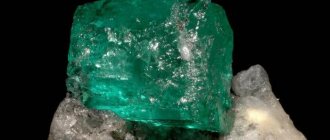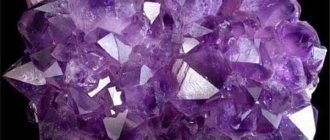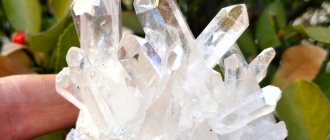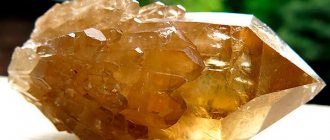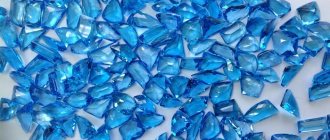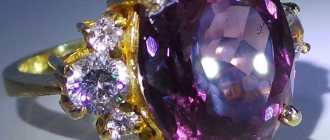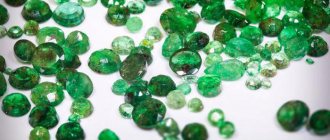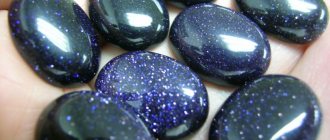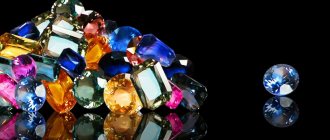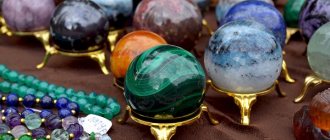Why do they love blue stones?
The color of the bottomless spring or summer sky and warm seas evokes only positive emotions. It is associated with purity, sincerity, and is guaranteed to attract the eye.
Adherents of esoteric teachings insist on the special meaning of the color blue. Here it is a symbol of contemplation, reflection, spiritual development.
If a person likes blue shades, he is almost certainly an open soul, a reliable companion and a person who is difficult to anger.
Natural stones the color of the sea and sky are prescribed as a sedative for overly excitable people. Therefore, the color is popular in home decor.
Assortment of minerals
The names of blue stones are present in all jewelry “sections”. Almost everything is distinguished by a wide range of colors and a variety of shades.
Precious
This segment includes blue varieties of diamond and sapphire.
Diamond
Diamonds of a rich celestial range are found in very few cases. The diamonds obtained from them are several times more valuable than white ones. This blue gemstone is sold exclusively at first-level auctions. Prices are seven figures in dollars.
Jewelry with diamond
Sapphire
The most expensive representative of this shade in the family is cornflower blue sapphire. The blue stone is mined in Kashmir and is a rare variety available to a select few. The cost is tens of thousands of dollars per carat.
Silver ring with blue sapphire
Semi-precious
The list of titles is more diverse. It also includes types of blue stones that are only formally not included in the “precious” segment.
Aquamarine
A translucent hard variety of beryl. The name is translated from Latin as “sea water”. The classic range is blue; specimens with a greenish “sea” tint are not uncommon. The color of aquamarine changes depending on the lighting, and fades in the harsh sun.
Jewelry with aquamarine
The extraction of high-quality raw materials is established in Sri Lanka, Russia (Ural), Norway, Argentina, and Ireland.
Spinel
The blue variety of the stone is found in Afghanistan and Sri Lanka. It is very rare, equated to precious ones, and therefore is often more expensive than the red “classic”. The transparent mineral is preserved for premium-level jewelry or mineralogical collections; it is used to encrust icons and other church paraphernalia.
Zircon
In nature, the celestial variety is rarely found. More often, shades of blue are obtained by firing brownish specimens. The result is worthy. And the natural semi-precious stone fully replaces expensive sapphires, topazes, and aquamarines. True, in this capacity in jewelry it is crowded out by artificial stones - cubic zirconia and moissanite.
Topaz
The translucent blue mineral topaz is the most popular in the family (there are also yellow, red, brownish, pink). Samples that combine two or three shades (polychrome) are valued.
Silver ring with topaz
The main places of production are Brazil and Switzerland. In Russia, deposits are concentrated beyond the Urals: Transbaikalia, Chukotka, Primorye.
Larimar
The “youngest” mineral: discovered in the Dominican Republic after the 1950s. The dullness plus the heavenly hue created by vanadium impurities make it indistinguishable from turquoise. Larimar is mined in America: USA, Canada, Caribbean countries.
Pendant with larimar
Tourmaline
The blue variety of the mineral includes two types - Paraiba and indigolite. The first, blue with a greenish tint, is named after the Brazilian province where it is mined. The second is a heavenly range with colors from spring blue to dark twilight.
Paraiba Tourmaline
Paraiba is equated to the precious segment due to its rarity and aesthetic qualities.
Ornamental
The peculiarity of blue minerals in this segment is their beauty and demand among jewelers and stone cutters. The best decorative specimens (for example, turquoise) are comparable to semi-precious ones.
Amazonite
Opaque mineral of delicate green-blue color. Great in all types of jewelry and products. But it is not recommended to wear Amazonite directly on the body.
Turquoise
The number one blue stone in the East. Unlike the “young” white and “old” green, blue and gray-blue shades are inherent in mature turquoise. This is the highest quality type of stone. It is used by jewelers and used to decorate the outfit of a Muslim bride. Inclusions with veins make each specimen exclusive, but pure blue is recognized as the most valuable. Such gems are mined in Iran.
Turquoise blue
Apatite
Impurities in the composition give apatite different tones, including blue. Splashes of white, green, and pink colors create a unique pattern with sparkles.
Bracelet with apatite
The ornamental stone apatite is often used as an imitation of other minerals.
Lapis lazuli
An opaque bright gem of pure blue – lapis lazuli classic. It is complemented by blue or purple specimens with a greenish tint.
Bracelet with lapis lazuli
The niil variety (indigo-colored specimens) is prized. The cost of light blue (asmani) and blue-green (sufsi) lapis lazuli is more affordable.
Sapphirine
Not particularly durable, 6–7 Mohs points, agate from the group of quartz minerals (chalcedony).
The coolish light blue deep shade makes it regal, while the gloss or matte texture adds variety.
Sapphirine stones
Cabochon-cut and framed in silver.
Adularia
A blue-white variety of moonstone. Named after Mount Adula (Switzerland), near which it was found. The bluish-grayish tints look mysterious, which is why the white-blue mineral, although inexpensive and often found in nature, is loved by jewelers.
Adularia
Coral
A real exotic is the gray-blue or blue coral growing in the Pacific Ocean. Its “branches” resemble human fingers. The second name for blue coral is “akori”.
Blue coral bracelet
Nephritis
Cult gem of China. The dark blue stone is called “dianite” and is valued above the ordinary white or green material.
Dianite or blue jade
OPAQUE OPEN STONES
Ornamental blue stones are used both in the production of stone-cutting products and in the form of cabochons for insertion into jewelry. Often, “ornamental” minerals mean less valuable stones. Opaque varieties are called “gems”, since there is no clear boundary between “jewelry” and “other colored stones”.
Turquoise
Turquoise
The blue-gray mineral is one of the most popular semi-precious ornamental stones. Opaque, with a slight waxy sheen, it can be in the following shades:
- sky blue;
- blue-blue;
- green-blue;
- pale green.
High-quality blue turquoise is easy to grind and polish and retains its original color for a long time. When heated, it cracks and turns brown, which distinguishes it from fakes, and is soluble in hydrochloric acid. The retail chain mostly presents artificial blue turquoise made from painted plastic, ceramics, and copper aluminophosphates.
Lapis lazuli
Lapis lazuli
The aqua to dark blue colored stone is a sulfate-containing, opaque mineral.
In jewelry, only lapis lazuli is used without light inclusions and has a uniform, rich color:
- cornflower blue;
- dark blue;
- purple.
The stone is easy to process (grinding, polishing). The most expensive Badakhshan (Afghanistan) mineral usually contains inclusions of golden pyrite.
We recommend: Green gems: TOP-18
Decorations
The range of blue minerals makes it easier to comply with the rules for their use in jewelry:
- Precious blue diamonds or sapphires are luxurious in any piece of jewelry. The frame is almost always chosen to be platinum or white gold. Such things are worn with a luxury wardrobe for events of the same level.
- Semi-precious stones are more democratic and universal. Even massive beads or bracelets look airy and graceful. Jewelry in silver is suitable for a walk, office or home.
- Costume jewelry made from artificial minerals does not have a frame or is framed with a jewelry alloy. This is a children's or youth range.
The richness of shades makes it possible to use jewelry with blue stones for people of all ages.
Gold earrings with deep muted inserts will decorate a mature, respectable lady. Such stones can replenish the men's assortment (cufflinks, signet). Bright blue and shine are the privilege of children and young girls.
Rules of care
You need to care for jewelry with soft blue gems in the same way as other minerals:
- they are protected from contact with perfumes, cosmetics, and household chemicals;
- store separately, especially not very hard stones (moonstone, turquoise, corals);
- wash only with soap and water.
Almost all blue stones are afraid of the sun - with such exposure they fade or fade. Therefore, jewelry is not worn to the beach or pool.
Spinel
This name was given to the blue colored stone (found in Afghanistan and Sri Lanka) by the inhabitants of the Roman Empire. Previously, it sounded like spinella, which literally translates as “thorn.” This is not surprising, because in nature this mineral has an extremely sharp and angular shape. The name was later transformed into the German word spinnel, which is still used today. This stone is considered very rare, so its cost is extremely high. Most often found in very expensive jewelry, in private collections and in the inlay of church attributes.
Spinel is considered a stone of love and happiness. Finding it is as difficult as true love. The mineral can be worn every day in a ring or pendant, or it can be stored at home - this will not diminish its properties. Along with all this, the stone is suitable for healing the body, strengthening the immune system.
Now we move on to consider semi-precious blue stones. Their names, features, photographs and specifics will be described below.
Magic properties
The energy of blue minerals, like colors, promotes spiritual development, lifts you above vanity, and encourages you to think about the eternal.
Overall Impact
The properties of blue minerals are very useful to humans:
- help to convince interlocutors, to be a speaker;
- relieve tension, make you more sociable;
- activate talents, imagination, intuition;
- attract luck;
- increase the desire to expand their horizons.
Blue stones are not used as a protective amulet: their energy does not create a protective “cocoon” for the human biofield.
However, it concentrates the radiation of the Cosmos in the area of the “third eye”.
If the thoughts are pure, it will open, and the person will gain paranormal abilities.
Influence of individual minerals
Each stone also has its own influence on a person:
- Sapphire. By meditating on a stone, you can soar to spiritual heights. Prolonged contemplation awakens joy and other positive things. It is better to wear it with gold jewelry.
Blue sapphire is a masculine attribute; ladies should not overuse it so as not to lose their femininity.
- Lapis lazuli. A truly feminine stone, but constant wearing is undesirable: the owner can be overwhelmed by frigidity. Gold and silver are considered ideal frames. Other metals disrupt the “magical” effect of the stone. Any jewelry except rings.
- Turquoise. Her mission is to bring lovers or spouses closer together. The owner of the jewelry can become a clairvoyant. Gray-blue stones are intended for people of mature age, especially spiritually developed ones. Young people can become overexcited even from wearing a pendant or pendant. The mineral is magnificent in silver.
- Aquamarine. Awakens nobility, loyalty, and other virtues in the owner. But the admixture of green reduces the effect of blue, so one does not meditate on this stone. This is a talisman for ship personnel, travelers, and business travelers (especially at sea). If you have any doubts about a trip, two to three weeks before the trip, wear the ring with the stone constantly and listen to your inner voice. The mineral awakens intuition. Under normal conditions, you can wear it all day, but take it off at night.
- Spinel helps preserve a family or relationship.
- Amazonite. Harmonizes space and people's mood. But they don’t meditate on it, but move it around the house from time to time. The presence of green shades makes it an amulet. Develops the gift of foresight, especially in silver.
Minerals of blue shades are useful for natures intolerant of the shortcomings of others or fixated on the material sphere.
Sapphire
This is the king of blue and blue stones, which everyone associates with the sea, silence, grandeur and peace. In nature, there are also green, pink, yellow and other types of sapphire, but the light blue shade of this stone is on the agenda. It is in this color that it is most often used by jewelers in the manufacture of earrings, pendants, necklaces and bracelets. The density of the stone is 9 units, and particles of iron and titanium give the mineral its coveted sea shade.
The stone received its strikingly beautiful name back in Ancient Persia. The people of this power that had sunk into oblivion believed that our Earth stood on a huge sapphire, and the sky was its reflection. The word itself is translated from ancient Persian as “blue”.
Like all existing stones, sapphire is credited with certain sacred properties. For example, it is believed that it gets rid of negative energy and puts you in a calm and peaceful mood. Allows you to more soberly assess the situation, not pay attention to trifles and confidently develop according to the planned plan. This unique blue stone is also believed to attract fidelity and love, help combat insomnia and even treat diseases such as asthma and cancer.
Therapeutic effect
The energy of stones helps with inflammatory processes and relieves pain.
Water
A popular healing “tonic” is water infused with blue stones. It cleanses the chakras and heals the body as a whole.
The stones are immersed in water for a day, then drunk half a glass or a glass per day (depending on body weight and health status). The course of treatment is every other week. If you don’t want to drink the infusion, then you don’t need it.
Minerals
Each blue pebble helps in its own way:
- Sapphire fights cancer. Also, its mission is to teach the owner, by listening to the body’s signals, to heal himself and heal others.
- Lapis lazuli heals nerves and heart. It can be infused in water or applied to a sore spot.
- Gray and green-blue turquoise treats the gastrointestinal tract, heart, nervous system, and relieves depression. However, its effect is significant, so it is necessary to use stones as medicinal ones without fanaticism.
- Topaz relieves stress, strengthens the thyroid gland, helps with gout, other ailments of the musculoskeletal system and chronic or nervous diseases. Useful for women with hormonal disorders and infertility.
- The increased healing properties of aquamarine are associated with the green-blue color “duet”. It helps get rid of blindness. Treats the heart, gastrointestinal tract, eliminates discomfort associated with problems of the genitourinary system. The pebble is applied to the sore spot or nearby. Vegetative-vascular dystonia is alleviated by a bracelet in gold, silver or copper.
- Amazonite heals the heart (pendant, pendant) and the genitourinary system. Particularly strong in silver.
Blue crystals treat the skin, gastrointestinal tract, kidneys, liver, thyroid gland. Useful for sleep disorders, depression, and other mental problems.
Such stones are useful for restless, hyper-alert people. They will calm down and begin to enjoy simple things.
Chalcedony
Many historians and simply lovers of learning something new ask the question: “What is the name of the blue stone, which was the most popular among the Romans?” These ancient people were very fond of using the semi-precious mineral chalcedony, once discovered in the Bosporus region. The name comes from the city of Chalcedon, near which the stone was discovered. The density of the mineral is 6-7 units, it has a delicate, coolish light blue tint. The texture of the mineral can be either glossy or matte.
The ancient Romans believed that chalcedony was a stone of love. He did not attract passion, but attracted true feelings that could last a lifetime. It was also believed that the stone served as a source of joy in painful and boring sea voyages. Nowadays, chalcedony is believed to treat various mental disorders. It eliminates insomnia, banishes nightmares, and allows you to quickly cope with stress and depression.
Blue stones and the Zodiac
Favorites of stones of heavenly shades are Water and Air signs of the Zodiac. They make the former less emotionally constrained, while the latter will be “forced” to develop, work on themselves and be less nervous.
But blue stones are suitable for the horoscope and other Zodiac inhabitants:
- zircon is useful for Sagittarius;
- Moonstone helps Leos;
- Amazonite patronizes Taurus;
- aquamarine belongs to Pisces.
There are universal minerals that are suitable for almost everyone according to the Zodiac: sapphire (except Capricorns), apatite (except Pisces).
Turquoise suits everyone equally. Everyone loves topaz (but Scorpios are favorites), spinel (Virgo), chalcedony (Gemini, Capricorn, Leo).
Compatibility
With zodiac signs
Sapphire can be worn by everyone except Capricorns. Aquamarine is recommended for water element zodiac signs; it is an excellent protector for Pisces. Topaz is the best stone for Scorpios. Spinnel is a reliable defender for Virgos. Chalcedony is recommended for use by Leos, Capricorns and Geminis; it has no contraindications for wearing by other signs.
Zirconium will be a wonderful stone for Sagittarius, while Cancers and Pisces should take a closer look at other stones. Moonstone is recommended for water signs. Apatite is in harmony with all representatives of the zodiac circle, except Pisces. Amazonite will become a reliable patron of Taurus. Turquoise suits absolutely everyone.
With names
Suitable names - Boris, Gleb, Grigory, Artem, Arkady, Vadim, Mikhail, Evgenia, Elizaveta, Zoya, Ksenia, Marina, Lyubov, Yulia, Yana.
With other minerals
Blue stones should not be combined with stones of charcoal, yellow, or orange tones.
Why do you dream about blue stones?
Dreams with blue stones are not uncommon, but they are interpreted differently.
General interpretation
The interpretation of dreams with blue stones is twofold:
- Miller's dream book (number one in terms of authority) connects blue stones with intuition, the spiritual world, and high human impulses. Perhaps there is a dreamer dozing within the dreamer. Often, after dreaming about blue stones, personal life improves, and cherished dreams become reality.
- A stone of this scale also dreams of an illness (of moderate or less severity) or problems that are not worth much worry.
- Some dream books say that blue stones in a dream promise protracted disputes or conflicts in reality. The person will probably feel bias and nagging from superiors or colleagues. The real reason for them will most likely be the love of freedom and defending their own views.
Dream books advise not to change your behavior style.

